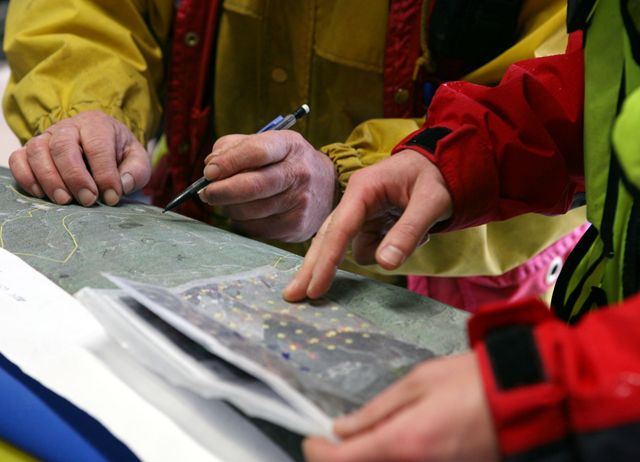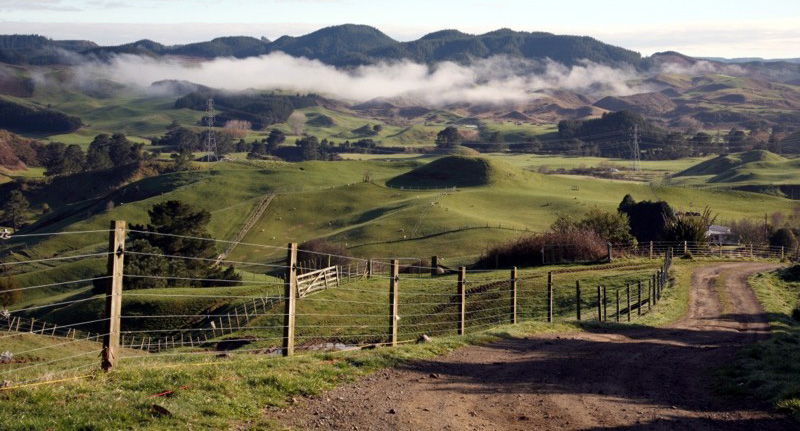 Winter in New Zealand's North Island is wet. While the E-SCAN instrumentation works fine, everything else has to adjust to the conditions. Rain apparel, plastic laminated maps, special wire, and special control and system management software all come into play. Damaged wire insulation that was undetectable (and irrelevant) in dry conditions suddenly becomes a significant issue, both for the signal level wiring (most of the system), but especially for the few current delivery wires.
Winter in New Zealand's North Island is wet. While the E-SCAN instrumentation works fine, everything else has to adjust to the conditions. Rain apparel, plastic laminated maps, special wire, and special control and system management software all come into play. Damaged wire insulation that was undetectable (and irrelevant) in dry conditions suddenly becomes a significant issue, both for the signal level wiring (most of the system), but especially for the few current delivery wires. Message to clients: Rain will slow a survey down. If you have control over when you plan a survey, assume that the least-rainy season will usually be the most cost-effective time for running 3D E-SCAN.
For expected rainy conditions, it is worthwhile to start with new wire, free of nicks and insulation damage. Then, select the appropriate wire for the wet conditions, for each aspect of layout and shooting,- this is mostly an issue of increased insulation thickness for at-risk areas.
In uninhabited areas, wire issues are minimal, even in the rain. Wire can be hung on bushes, branches, laid on grass and mud, and it will remain intact and functional. In an intensely agricultural area like some of the New Zealand 3D E-SCAN survey areas, wire must be managed around roads, lanes, cattle tracks, pens, and fields,- all of which entail opportunities for somebody or something damaging wire insulation and creating leaks or grounding.
E-SCAN's system management software has the capability to test for breaks and unintended grounding throughout the system, working with crew members in the field who will respond to operator requests to lift, cut or ground a wire in some specific location to help track down an issue that is otherwise seen only as "this 400 metres", or "this wire segment from here to here". In the wet farm country surveys of New Zealand, on the worst days we needed up to half a day to diagnose, repair and maintain the sometimes 50,000 metres of survey wire in use at any one time. With a delayed mid-day start for the day's actual data collection, the 3D E-SCAN could still acquire most of a normal day's measurements (several thousand) by pushing into the darkness before quitting. A well-motivated field crew makes the difference in keeping up production when field conditions turn bad.
We can also work pro-actively to minimize rainy weather productivity losses. Knowing we may have repairs in the morning, some system layout activities and post-survey clean-up activities can be scheduled to be done while repairs happen, accomplishing necessary work while at the same time having crew available for system repairs as they are identified. Knowing we will be subject to rain means that we can set up differently in the first place. Time is taken to secure wire away from susceptible areas, such as raising it over driveway entrances or over lanes where it won't be run over. Using special heavy-insulation wires segments where ground traffic can't be avoided. Installing checkpoints in long wire runs that can be accessed for quick ohm-meter checks during troubleshooting. These are all quick and simple preparations that really pay off in extended rain periods.
Between very capable system management software and a lot of operating experience in wet conditions, any 3D E-SCAN survey that must be done in the persistent rain conditions will generate the required quality-verified 3D raw data sets, at a time and cost premium of 20% to 35% for the rain-affected days. An occasional rain shower causes almost no delay or extra cost. Time, cost, risk?

If conventional geophysics is a bunch of things trying to go wrong at the same time, imagine distributed acquisition or E-SCAN. That's why any normal deployment of an E-SCAN system includes many special supplies intended to avert or quickly fix the many things that can come up on a "normal" day.
We don't count on line-of-sight radio contact,- we always bring a repeater station and the means to power it up in any location. We can't count on not finding wire-eating animals in an area, so we always bring a variety of supplies and devices so that, for example, where bite damage is repeatedly occurring, we can elevate (or re-route) the wire and avoid the next bite from the rabbit that claims that 50 metre stretch of desert as his own, every night. Armored cable, for road crossings where there are no trees to assist in going "up and over", and no culverts to go under.
We don't know when we will encounter an unexpected obstacle, so we bring wire-flinging tools and supplies, and enough wire to re-route around anything. Sometimes a 250 gram lead fishing weight in your cruiser vest pocket is the only thing keeping you from a half-hour search for a decent throwing rock. Extra batteries, and backups for every key instrument, ATV, radio, GPS and generator. Not 10 rolls of tape,- 200 or more.
Once we start, with all that wire spread out, we don't want to stop for anything, least of all to make a 100 mile drive to Wal-Mart for something we didn't bring, and know we should have, (only to find that Wal-Mart is sold out).
In rainy conditions, there may be no alternative other than to replace entire sections of wire that show as leaking... the cost of replacement is often much less than the cost of delays in trying to detect a small insulation breach in a long wire. Having spare wire at the survey site is essential.
"A few hundred pounds of prevention...
We don't count on line-of-sight radio contact,- we always bring a repeater station and the means to power it up in any location. We can't count on not finding wire-eating animals in an area, so we always bring a variety of supplies and devices so that, for example, where bite damage is repeatedly occurring, we can elevate (or re-route) the wire and avoid the next bite from the rabbit that claims that 50 metre stretch of desert as his own, every night. Armored cable, for road crossings where there are no trees to assist in going "up and over", and no culverts to go under.
We don't know when we will encounter an unexpected obstacle, so we bring wire-flinging tools and supplies, and enough wire to re-route around anything. Sometimes a 250 gram lead fishing weight in your cruiser vest pocket is the only thing keeping you from a half-hour search for a decent throwing rock. Extra batteries, and backups for every key instrument, ATV, radio, GPS and generator. Not 10 rolls of tape,- 200 or more.
Once we start, with all that wire spread out, we don't want to stop for anything, least of all to make a 100 mile drive to Wal-Mart for something we didn't bring, and know we should have, (only to find that Wal-Mart is sold out).
In rainy conditions, there may be no alternative other than to replace entire sections of wire that show as leaking... the cost of replacement is often much less than the cost of delays in trying to detect a small insulation breach in a long wire. Having spare wire at the survey site is essential.
"A few hundred pounds of prevention...
Animals damaging wire insulation is the principal cause of wet-weather maintenance delays.
Damaged insulation is workable as long as the damaged length is dry and suspended in air.
On the ground, or contacting foliage, insulation damage becomes unacceptable, but at least
it is now routinely detectable by a range of line-monitoring devices and QA/QC procedures.
In much of New Zealand's North Island, sheep, cattle, deer, and elk farms are "everywhere",
mandating special considerations to maintain verifiable wire circuit (and data) integrity.

Damaged insulation is workable as long as the damaged length is dry and suspended in air.
On the ground, or contacting foliage, insulation damage becomes unacceptable, but at least
it is now routinely detectable by a range of line-monitoring devices and QA/QC procedures.
In much of New Zealand's North Island, sheep, cattle, deer, and elk farms are "everywhere",
mandating special considerations to maintain verifiable wire circuit (and data) integrity.
